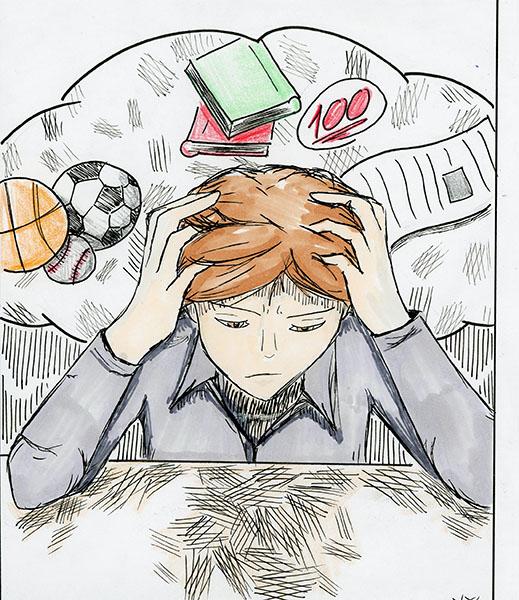Student athletes overcome pressures from all sides

Art by Kenny Yi
Each day, athletes face various pressures and difficulties in their respective sports. On the outside looking in, an athlete’s challenges may seem obvious—competition for playing time, overcoming fatigue and the like, but are these really the only troubles that student athletes face, or are the pressures placed on student athletes more complex than an outsider could imagine?
In reality, athletes are dealing with much more than what meets the eye. Mr. Jason Kuffel, assistant coach for the varsity boys’ basketball team and the varsity boys’ lacrosse team, shares insight on the struggles of athletes.
One of these pressures, Coach Kuffel says, is simply the high level, and therefore high expectations, of varsity sports.
“As varsity players, there are a lot more expectations that come on them, from film study, to individual work, to in-season and out-of-season workouts, to practices, to showing up on time, to academics, to applying to colleges,” said Coach Kuffel.
Mr. Martin Jennings, Saint Viator’s athletic director, also touches on the pressure an athlete can experience when faced with balancing friends and sports.“Friend groups may put pressure on an athlete by the expectations they set in regards to time away from school and sports,” said Mr. Jennings.
Sam Brey, a senior on the varsity boys’ Cross Country team, also says that pressure to balance school and sports can be consuming for an athlete.
“School can be a pressure, like the amount of homework we have,” said Brey. “You have to get your schoolwork done and then also have a sport that takes two hours after school, and sometimes you have to go down to the weight room and do other things that take extra time.”
Additionally, a majority of student athletes want to use their athletic capabilities to bring pride to their families, school and teammates.
“[Student athletes] want to perform well for their teammates, classmates and school,” said Coach Kuffel. “They take a lot of pride in that and want to do well.We’re a small knit community here, and we want to do well and make Saint Viator proud. The other pressure is family—you want to do well and make your family proud. I think for our students, our families spend a lot of time with us and make a big commitment to helping you become a better student athlete, whether it’s private lessons or parents paying for club sports.”
Mr. Jennings places an alternate spin on the topic of an athlete’s family, explaining that parents can place different types of pressures on athletes depending on the situation.
“Parent pressure can come in two forms—indifference or overemphasis,” said Mr. Jennings. “Parents walk the fine line of supporting their athletes and not putting too much pressure on them.”
Mr. Jennings realizes that there are many pressures that athletes must overcome; yet, he says that the hardest one to cope with is not being prepared, as well as the frustration that comes from this problem.
“The hardest thing for an athlete to face is lack of preparation, whether it is losing a game, or not playing as much as one thinks or desires,” said Mr. Jennings. “Dealing with a lack of preparation is not always the first thing you see, but it is usually the cause of all failures. Failure is usually what we point to first whether it is losing a game or not playing enough.”
Looking at the many pressures placed on athletes’ shoulders, another question arises: how do athletes cope with these stressors? Coach Kuffel mentions that a supportive coaching staff and athletic program can aid athletes as they grapple with their athletic pressures and expectations.
“I think for coaches, building that relationship within their program with their students to get to know them, and the students having a comfortable level to speak to [their coaches] while they are struggling is very important,” said Coach Kuffel.
Brey also explains that a positive team atmosphere is helpful for an athlete to relieve stress.
“I try to have fun with it,” said Brey. “On the cross country team we’re all there to help each other, and we’re just having fun. We’re not always serious, which takes some pressure off and makes it a little bit easier.”
Additionally, Mr. Jennings explains that an athlete’s sense of community and support can aid in the struggles that a sport creates.
“The grit [of athletes] comes from an athlete’s competitive spirit,” said Mr. Jennings.
“This spirit comes through all of us in different ways, but it lies in each of us. I think it is up to the coaches, parents, friends and teammates to help each high school athlete find it. When we find it collectively, great things happen.”


